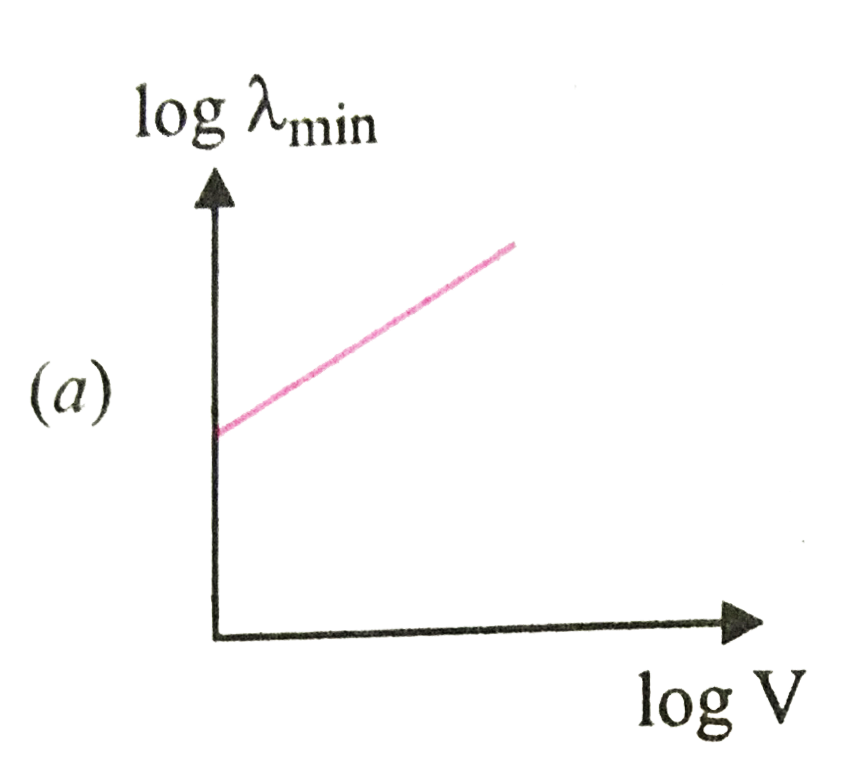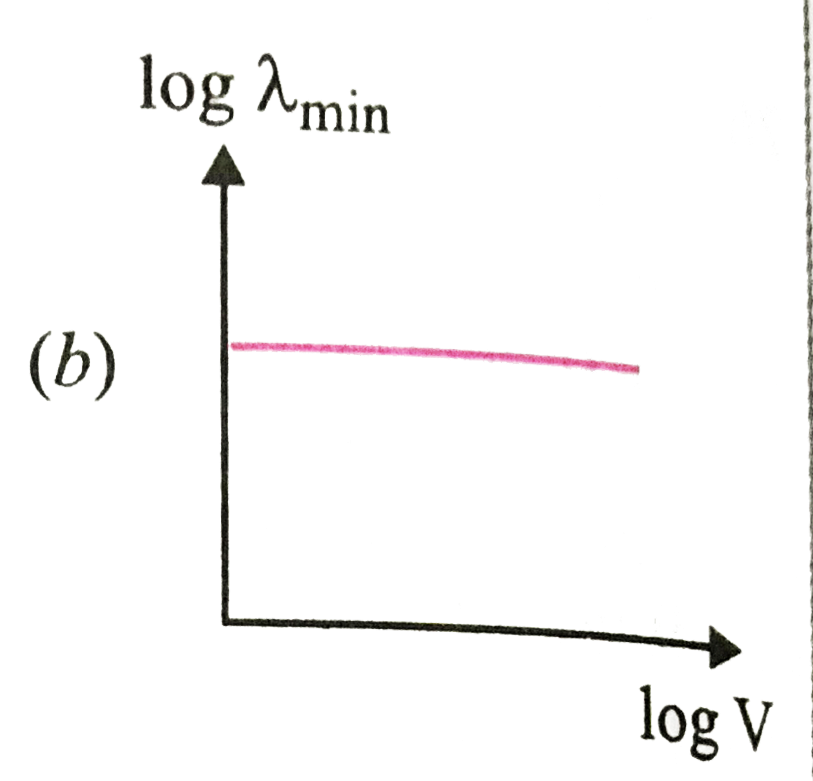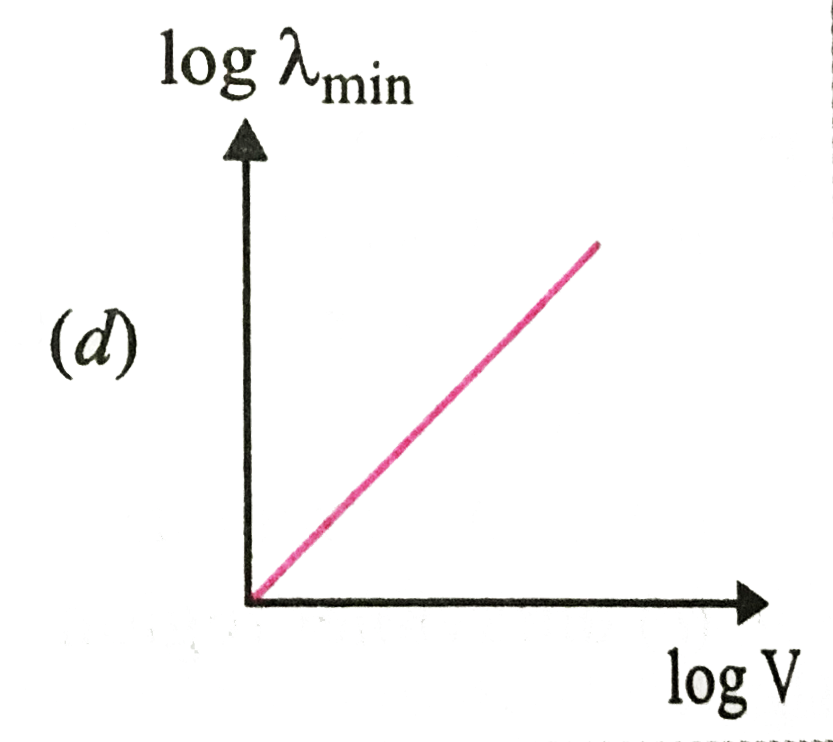An electron beam is acceleration by a potential difference V to hit a metallic target to produce X-rays. It produces continuous as well as characteristic X-rays. If λmin is the smallest possible wavelength of X-rays in the spectrum, the variation of logλmin with logv is correctly represented in




The correct Answer is:c
To solve the problem of how the minimum wavelength of X-rays (λmin) varies with the accelerating potential difference (V), we can follow these steps:
1. Understand the Energy Relationship:
When an electron is accelerated through a potential difference V, it gains kinetic energy equal to the work done on it by the electric field. This energy is given by:
E=eV
where e is the charge of the electron.
2. Relate Energy to Wavelength:
The energy of a photon (which corresponds to the X-rays produced) is related to its wavelength by the equation:
E=hcλ
where h is Planck's constant and c is the speed of light. For the minimum wavelength (λmin), we can equate the two expressions for energy:
eV=hcλmin
3. Rearranging for λmin:
Rearranging the equation gives us:
λmin=hceV
4. Taking Logarithms:
To analyze the relationship in logarithmic terms, we take the logarithm of both sides:
log(λmin)=log(hceV)
5. Using Logarithmic Properties:
Applying the properties of logarithms, we can separate the terms:
log(λmin)=log(hc)−log(e)−log(V)
This can be rearranged to:
log(λmin)=log(hc/e)−log(V)
6. Identifying the Linear Relationship:
We can express this in the form of a linear equation:
log(λmin)=−log(V)+log(hc/e)
Here, if we let y=log(λmin) and x=log(V), we see that this is a linear equation of the form:
y=mx+c
where the slope m=−1 and the y-intercept c=log(hc/e).
7. Graph Interpretation:
Since the slope is negative, this indicates that as V increases, λmin decreases. The graph of log(λmin) versus log(V) will be a straight line with a negative slope.
Conclusion:
The relationship between log(λmin) and log(V) is linear with a negative slope of -1. Therefore, the correct representation of the variation of log(λmin) with log(V) is a straight line with a negative slope.
When an electron is accelerated through a potential difference V, it gains kinetic energy equal to the work done on it by the electric field. This energy is given by:
E=eV
where e is the charge of the electron.
The energy of a photon (which corresponds to the X-rays produced) is related to its wavelength by the equation:
E=hcλ
where h is Planck's constant and c is the speed of light. For the minimum wavelength (λmin), we can equate the two expressions for energy:
eV=hcλmin
Rearranging the equation gives us:
λmin=hceV
To analyze the relationship in logarithmic terms, we take the logarithm of both sides:
log(λmin)=log(hceV)
Applying the properties of logarithms, we can separate the terms:
log(λmin)=log(hc)−log(e)−log(V)
This can be rearranged to:
log(λmin)=log(hc/e)−log(V)
We can express this in the form of a linear equation:
log(λmin)=−log(V)+log(hc/e)
Here, if we let y=log(λmin) and x=log(V), we see that this is a linear equation of the form:
y=mx+c
where the slope m=−1 and the y-intercept c=log(hc/e).
Since the slope is negative, this indicates that as V increases, λmin decreases. The graph of log(λmin) versus log(V) will be a straight line with a negative slope.
The relationship between log(λmin) and log(V) is linear with a negative slope of -1. Therefore, the correct representation of the variation of log(λmin) with log(V) is a straight line with a negative slope.
Topper's Solved these Questions
- BOOK - PRADEEPCHAPTER - DUAL NATURE OF RADIATION AND MATTEREXERCISE - Value based question1videos
DUAL NATURE OF RADIATION AND MATTER
- BOOK - PRADEEPCHAPTER - CURRENT ELECTRICITYEXERCISE - Problems for Practice (B)2videos
CURRENT ELECTRICITY
- BOOK - PRADEEPCHAPTER - ELECTROMAGNETIC INDUCTION & ALTERNATING CURRENTEXERCISE - Multiple Choice Questions1videos
ELECTROMAGNETIC INDUCTION & ALTERNATING CURRENT
Similar Questions
A beam of electron accelerated by a large potential difference V is mode of strike a metal target of produce X-ray . For which of the following value of V , will the resulting X-ray have the lower minimum wavelength?
View SolutionIn a X - ray tube , electrons accelerated through a very high potential difference strike a metal target . If the potential difference is increased , the speed of the emitted X - rays :
View Solution
Knowledge Check
- Question 1 - Select One
In producing X-rays a beam of electrons accelerated by a potential difference V is made to strike a metal target. For what value of V,X-rays will have the lowest wavelength of 0.3094 Å
A10 kVB20 kVC30 kVD40 kV - Question 2 - Select One
For continuous X-rays produced wavelength is
AInversely proportional to the energy of the electrons hitting the targetBInversely proportional to the intensity of the electron beamCProportional to intensity of the electron beamDProportional to target temperature - Question 3 - Select One
An X ray tube is operated at an accelerating potential of 40 kV. What is the minimum wavelength of X rays produced1?
A0.62 ÅB0.31 ÅC0.45 ÅD0.75 Å
Consider a photon of continuous X-ray and a photon of characteristic X-ray of the same wavelength. Which of the following is/are different for the two photons?
View SolutionWhen an X-ray tube is operated with an accelerating potential difference V, the cutoff wavelength is proportional to
View SolutionThe minimum wavelength λmin in the continuous spectrum of X-rays is
View Solutionλmin of X-rays depends on :-
View SolutionThe minimum wavelength of X - rays produced by electrons accelerated by a potential difference of volts is equal to
View Solution

